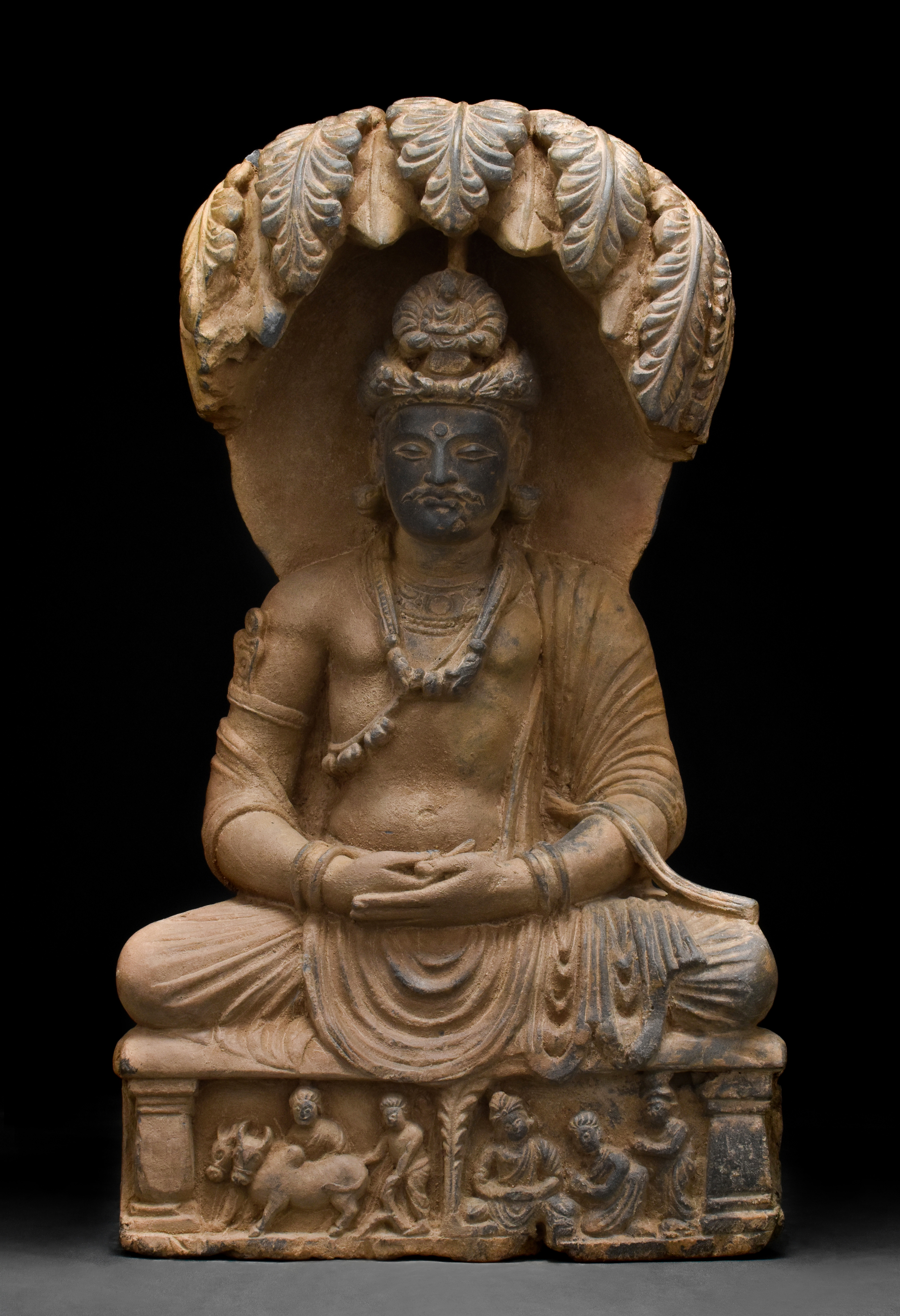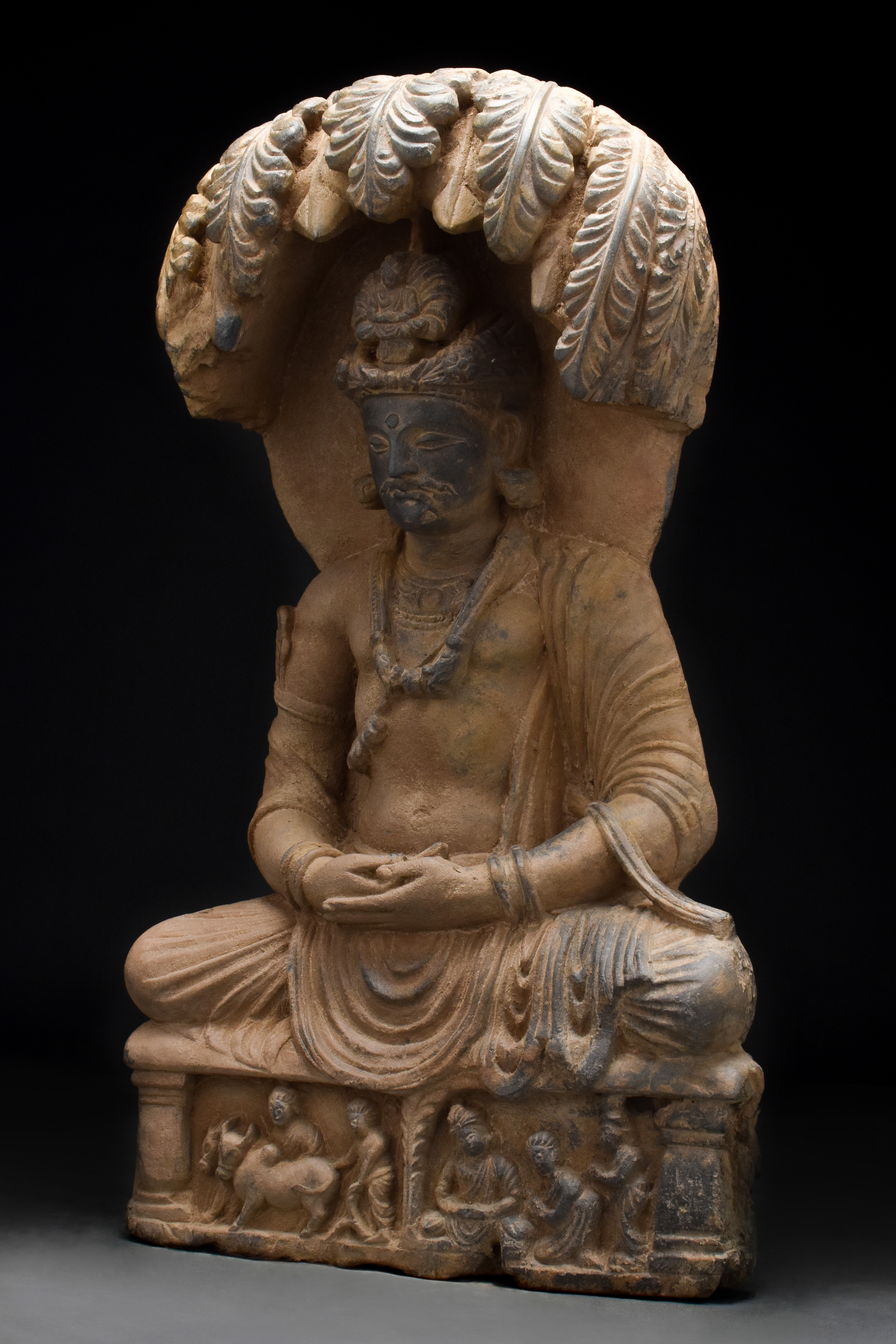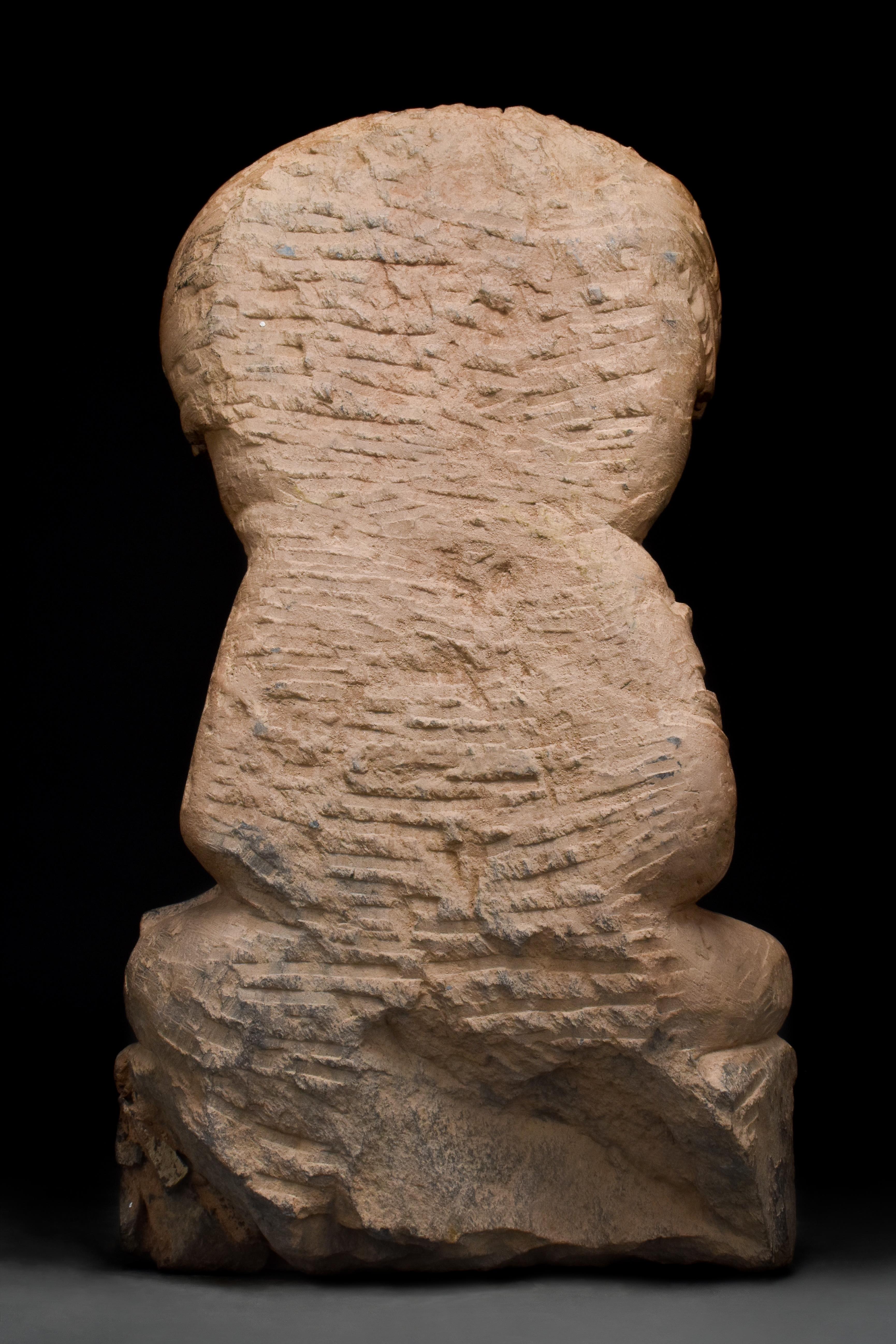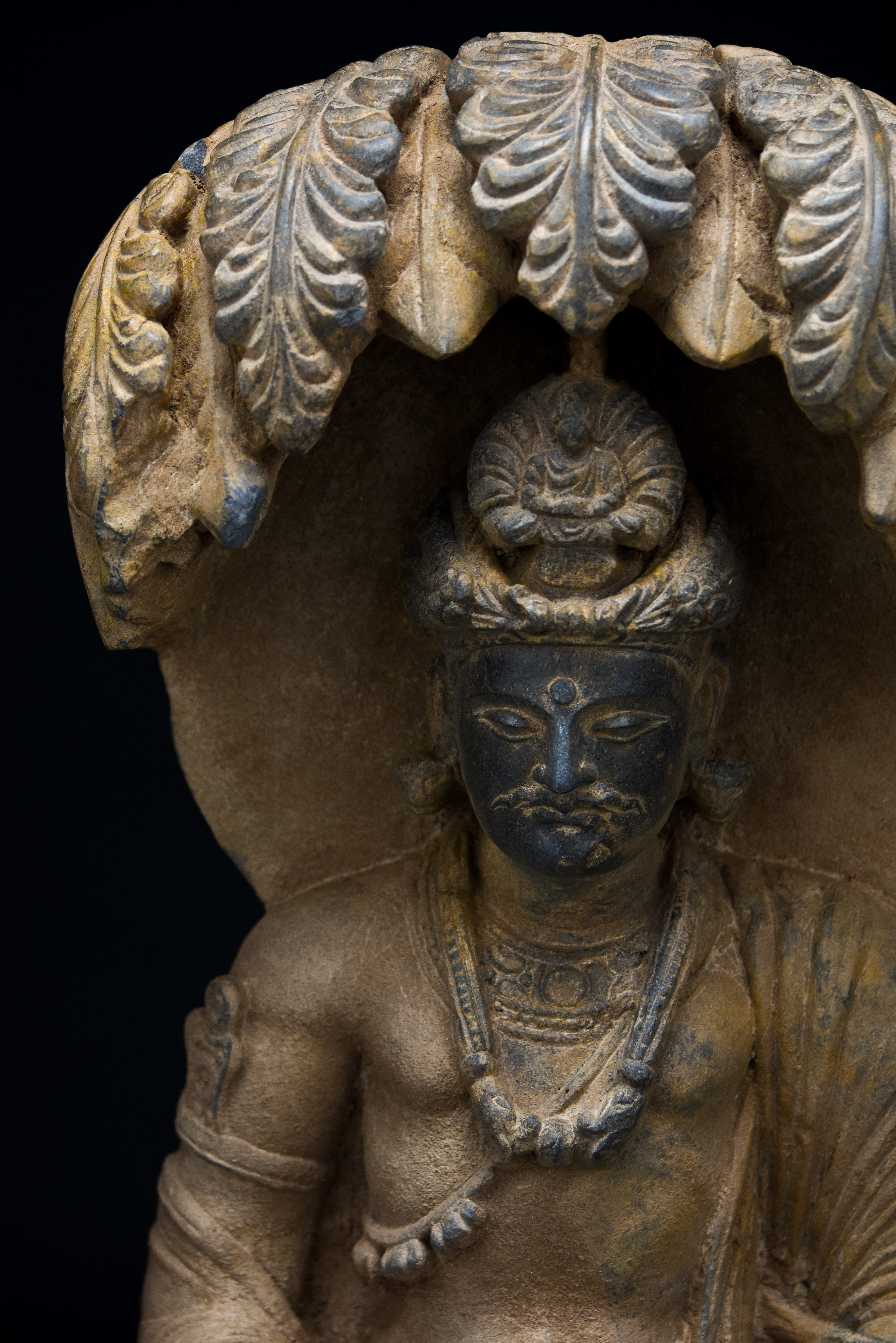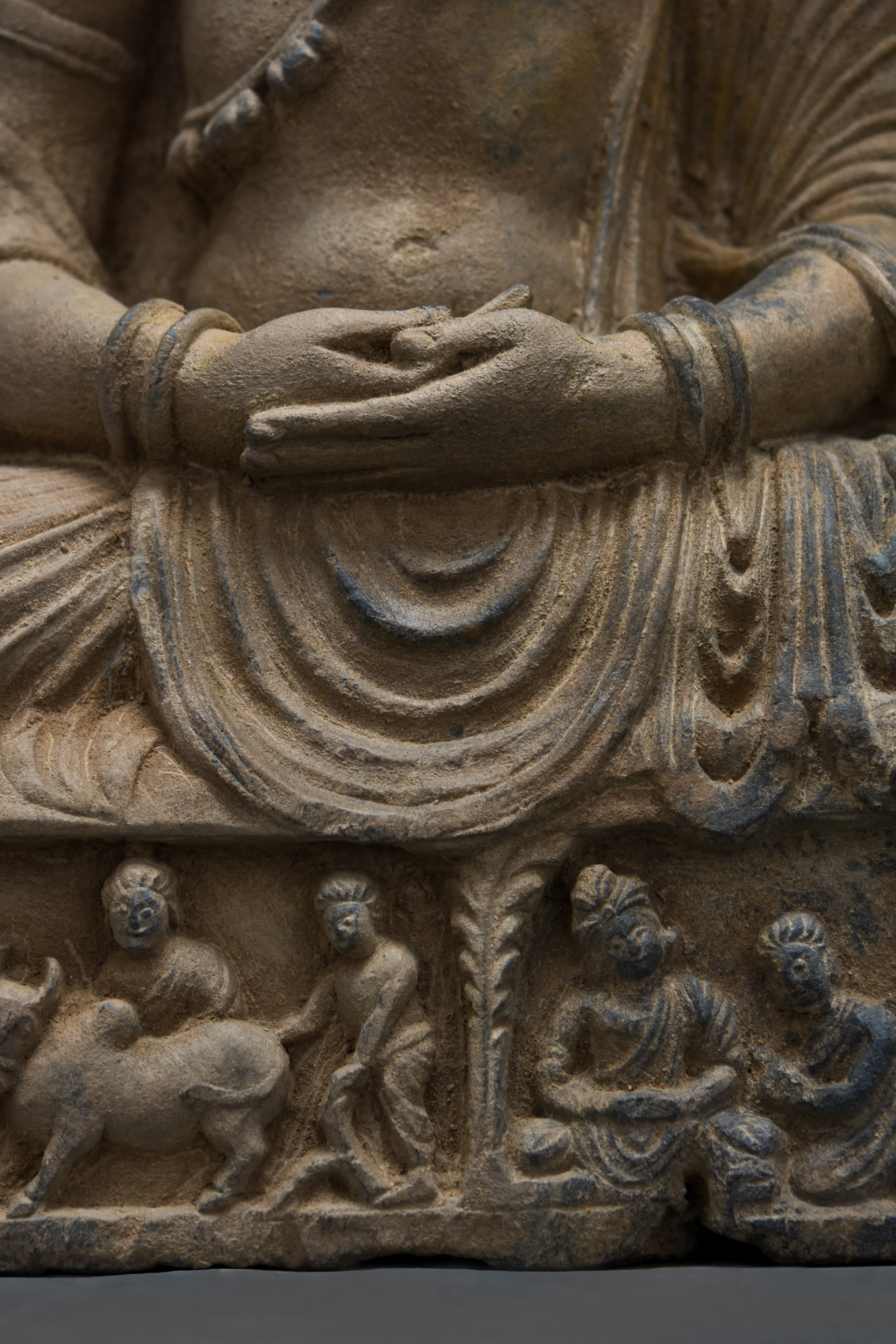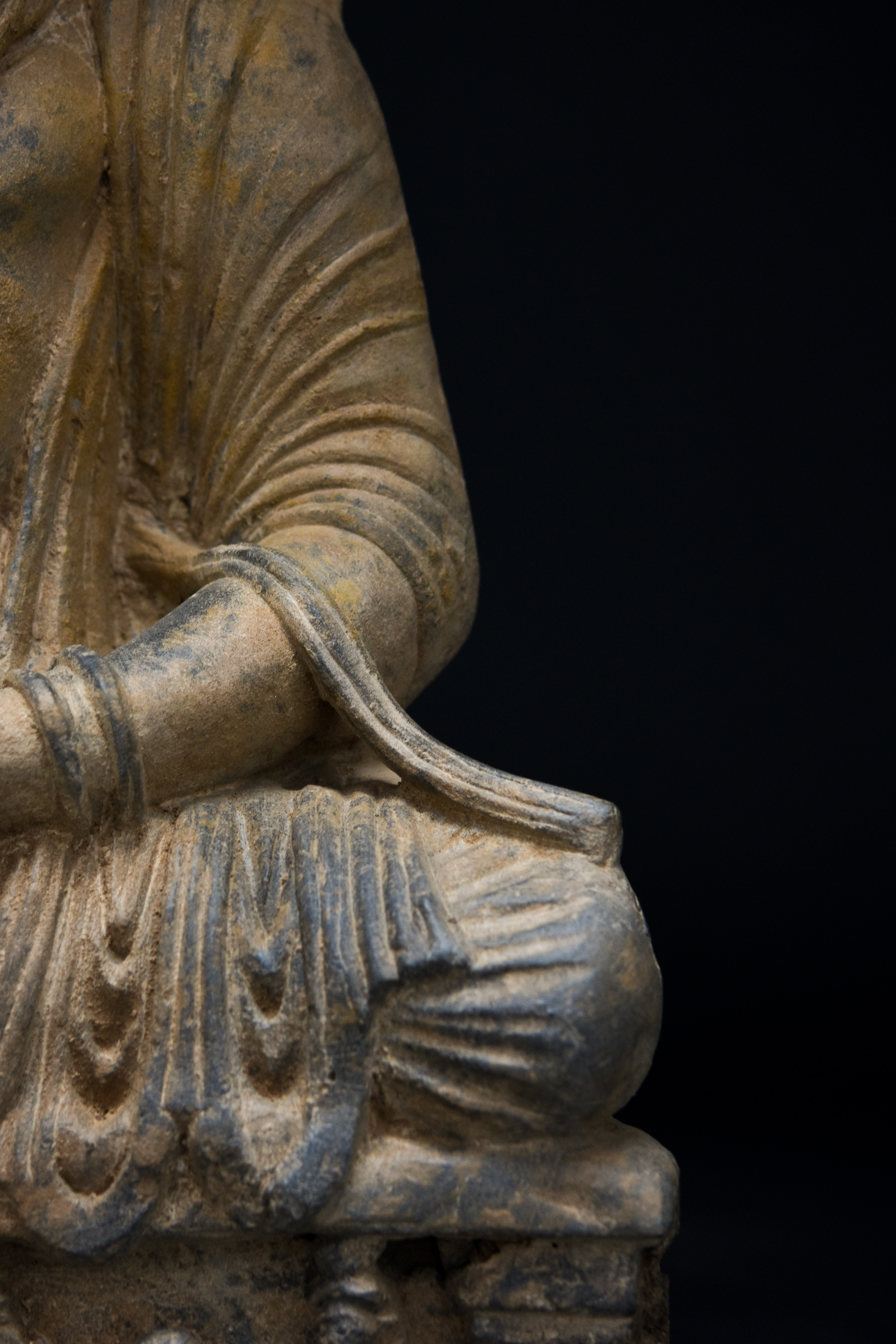10
PRINCE SIDDHARTHA GAUTAMA MEDITATING UNDER THE JAMBU TREE
Ca. 200–300 AD. A grey chlorite-schist statue of Prince Siddhartha Gautama meditating beneath the Jambu tree. The figure is shown with the body held with a degree of relaxed strength, the head held up and the eyes closed in meditation. Between the brows is he urna and the nose is straight with small mouth and moustache above. The hair is neatly arranged and pulled to the back of the head. To the top of the head is turban with large fan shaped crest to the front and decorated with a small bust of the Buddha. To the black of the head is a large halo. Around the neck are three strands of necklaces, one falling diagonally over the chest with a series of amulet cases known as kavacha. The torso is bare apart from a loose fitting robe that hangs over the left shoulder and falls to the lap. The figure is seated on a low platform supported to either end by Greco-Bactrian columns. To the centre of the platform is a scene depicting Prince Siddartha breaking his fast and receiving an offering of rice from a young girl. To the other side are farmers ploughing with oxen., the two scenes divided by a tree. The sculpture represents Prince Siddartha, who would go on to become the Buddha, or “Enlightened One.” It combines the imagery of two scenes from the life of the Buddha, both taking place under a tree. As a young prince, Siddhartha, was taken into the fields to witness a plowing contest. He observed men sweating and exerting themselves as well as birds swooping down from the sky devouring insects. He soon became overwhelmed by these events, as they reflected the misery of human life and the inevitability of death. He left the contest and wandered until he found a wood apple (jambu) tree. He sat beneath this tree and entered into a trance. This event was a precursor to his subsequent meditation under the bodhi tree, which is symbolised by the young girl giving Siddartha a bowl of rice. After leaving his life of luxury at the palace, the prince joined a group of ascetics, but the future Buddha realised that punishing the body was not the way to find enlightenment and an end to suffering; nor was an indulgent life of pleasure that he experienced as a prince. Nearly at the point of death, the Buddha accepted an offering of food from a young peasant girl and thus broke with the extreme views of the ascetics. After recovering his health the Buddha realised that a middle way was required to find salvation, and so he set off to find a place to meditate and find the answers to the end of suffering. At a royal deer park at Sarnath, near the holy city of Varanasi on the Ganges, the Buddha sat beneath a Bidhi tree and meditated. After several years of mendicancy, meditation, and asceticism, he awakened to understand the mechanism which keeps people trapped in the cycle of rebirth. The Buddha then travelled throughout the Ganges plain teaching and building a religious community. The Buddha taught a middle way between sensual indulgence and the severe asceticism found in the Indian shrama?a movement. He taught a training of the mind that included ethical training, self-restraint, and meditative practices such as jhana (meditation) and mindfulness. The Buddha also critiqued the practices of Brahmin priests, such as animal sacrifice and the caste system. The figure can be distinguished from the enlightened images of the Buddha by the sumptuous robes and jewellery. The Buddha as an enlightened being is shown in the simple robes of a monk, no longer requiring the trappings of the material world. The Jambu/Bodhi tree behind the figure is beautifully rendered and forms a canopy protecting the prince whilst he meditates, and is reminiscent of the Naga serpent spreading its protective hood, that is depicted in images when he becomes the Buddha. The face of the prince shows calm resoluteness in his pursuit of the truth. Sometimes the fan shaped crest to the diadem has a lion decoration to it, but in this case it is the figure of the Buddha, a symbol of what the young prince will achieve in the near future. The piece shows the clear and crisp rendering of the robes, that recalls the styles of Hellenistic sculptures. Very often there are architectural elements that hint at the fusion of cultures that took place in the Gandhara region. In this case the columns display a fusion of Greek and Bactrian styles, whilst at other times they can be either purely Greek or Persian. The item was researched by Bret Gaunt. For a similar image see The Metropolitan Museum of Art, accession number 2005.314. For more information about Gandharan art, see Jongeward, D. (2019). Buddhist Art Of Gandhara in the Ashmolean Museum. Oxford: Oxford University Press. Provenance: From the collection of a London gentleman; formerly acquired in early 2000s in France; previously in 1970s European collection. Size: L:650mm / W:370mm ; 30k+g
Ca. 200–300 AD. A grey chlorite-schist statue of Prince Siddhartha Gautama meditating beneath the Jambu tree. The figure is shown with the body held with a degree of relaxed strength, the head held up and the eyes closed in meditation. Between the brows is he urna and the nose is straight with small mouth and moustache above. The hair is neatly arranged and pulled to the back of the head. To the top of the head is turban with large fan shaped crest to the front and decorated with a small bust of the Buddha. To the black of the head is a large halo. Around the neck are three strands of necklaces, one falling diagonally over the chest with a series of amulet cases known as kavacha. The torso is bare apart from a loose fitting robe that hangs over the left shoulder and falls to the lap. The figure is seated on a low platform supported to either end by Greco-Bactrian columns. To the centre of the platform is a scene depicting Prince Siddartha breaking his fast and receiving an offering of rice from a young girl. To the other side are farmers ploughing with oxen., the two scenes divided by a tree. The sculpture represents Prince Siddartha, who would go on to become the Buddha, or “Enlightened One.” It combines the imagery of two scenes from the life of the Buddha, both taking place under a tree. As a young prince, Siddhartha, was taken into the fields to witness a plowing contest. He observed men sweating and exerting themselves as well as birds swooping down from the sky devouring insects. He soon became overwhelmed by these events, as they reflected the misery of human life and the inevitability of death. He left the contest and wandered until he found a wood apple (jambu) tree. He sat beneath this tree and entered into a trance. This event was a precursor to his subsequent meditation under the bodhi tree, which is symbolised by the young girl giving Siddartha a bowl of rice. After leaving his life of luxury at the palace, the prince joined a group of ascetics, but the future Buddha realised that punishing the body was not the way to find enlightenment and an end to suffering; nor was an indulgent life of pleasure that he experienced as a prince. Nearly at the point of death, the Buddha accepted an offering of food from a young peasant girl and thus broke with the extreme views of the ascetics. After recovering his health the Buddha realised that a middle way was required to find salvation, and so he set off to find a place to meditate and find the answers to the end of suffering. At a royal deer park at Sarnath, near the holy city of Varanasi on the Ganges, the Buddha sat beneath a Bidhi tree and meditated. After several years of mendicancy, meditation, and asceticism, he awakened to understand the mechanism which keeps people trapped in the cycle of rebirth. The Buddha then travelled throughout the Ganges plain teaching and building a religious community. The Buddha taught a middle way between sensual indulgence and the severe asceticism found in the Indian shrama?a movement. He taught a training of the mind that included ethical training, self-restraint, and meditative practices such as jhana (meditation) and mindfulness. The Buddha also critiqued the practices of Brahmin priests, such as animal sacrifice and the caste system. The figure can be distinguished from the enlightened images of the Buddha by the sumptuous robes and jewellery. The Buddha as an enlightened being is shown in the simple robes of a monk, no longer requiring the trappings of the material world. The Jambu/Bodhi tree behind the figure is beautifully rendered and forms a canopy protecting the prince whilst he meditates, and is reminiscent of the Naga serpent spreading its protective hood, that is depicted in images when he becomes the Buddha. The face of the prince shows calm resoluteness in his pursuit of the truth. Sometimes the fan shaped crest to the diadem has a lion decoration to it, but in this case it is the figure of the Buddha, a symbol of what the young prince will achieve in the near future. The piece shows the clear and crisp rendering of the robes, that recalls the styles of Hellenistic sculptures. Very often there are architectural elements that hint at the fusion of cultures that took place in the Gandhara region. In this case the columns display a fusion of Greek and Bactrian styles, whilst at other times they can be either purely Greek or Persian. The item was researched by Bret Gaunt. For a similar image see The Metropolitan Museum of Art, accession number 2005.314. For more information about Gandharan art, see Jongeward, D. (2019). Buddhist Art Of Gandhara in the Ashmolean Museum. Oxford: Oxford University Press. Provenance: From the collection of a London gentleman; formerly acquired in early 2000s in France; previously in 1970s European collection. Size: L:650mm / W:370mm ; 30k+g
Ancient Art and Antiquities
Auktionsdatum
Ort der Versteigerung
We offer fast domestic and international shipping with registered and insured mail.
We do the packing in our premises so you do not need to arrange it separately after the sale.
We are partners with DHL and FedEx so we always select the best and most affordable shipping option.
For any questions related to the packing and shipping please call: 0044/7424994167
Wichtige Informationen
After a major investment and change in management Pax Romana Auctions rebranded to become the exclusive London Apollo Galleries!
We are excited to present our November auction featuring great items from all over the ancient world! All pieces can be packed and shipped with our in-house white glove team in London.
We also accept phone bidders - please email our team to register. Finally, the sale is running on both Saleroom and on our website apollogalleries.com - join on our website to save up to 8% in commission.
AGB
Apollo Art Auctions Limited Terms and Conditions
- Terms of Sale
1.1 Apollo Art Auctions Ltd, a company registered in England with registered number 11450370 and with a registered office at 10-12 Mulberry Green, Old Harlow, Essex CM17 0ET ("Apollo Art Auctions". "we" or "us"), carries on business with Bidders, Buyers and Sellers (as defined below) on the following Auction Terms and Conditions, the Terms of Consignment for Sellers, and on such other terms, conditions and notices as may be referred to herein or that may be amended by way of notices posted in the saleroom or by way of announcements made by us.
1.2 Bidders should carefully read the Auction Terms and Conditions (the "Terms and Conditions") and Terms of Consignment for Sellers prior to bidding at auction, as Bidders and Buyers will be deemed to have accepted these terms and conditions once a bid has been placed.
1.3 We act as agent for the Seller whose identity, for reasons of confidentiality, is not normally disclosed to the Buyer. If a Buyer is the successful Bidder on the fall of the hammer, the contract of sale is made directly between the Buyer and the Seller.
- Definitions
In these Terms and Conditions, the following words have the following meanings:
Bid: an amount offered by a Bidder to purchase a Lot.
Bidder: the person considering, making or attempting to make a Bid on a Lot, in person or by any other means, including the Buyer.
Buyer: the Bidder who makes the highest Bid accepted by us.
Buyer’s Premium: The amount payable by the Buyer in addition to the Hammer Price on each Lot purchased, calculated as a percentage of the Hammer Price - 20 % (not including any online charges).
Date of Sale: the date on which we accept the Buyer's Bid for the Lot.
Deliberate Forgery: an imitation made with the intention of deceiving as to authorship, origin, date, age, period, culture or source but which is unequivocally described in the catalogue as being the work of a particular author, origin, date, age period, culture or source, and which at the date of the sale had a materially lesser value than it would have had if it had been in accordance with the catalogue description.
Hammer Price: the highest Bid reached (at or above any reserve) and accepted by us when we bring down the hammer and the sale of the Lot is final.
Lot: the item consigned by the Seller for sale at auction by us.
Purchase Price: the Hammer Price in respect of the Lot sold, together with any Buyer's Premium, Value Added Tax chargeable and any additional charges payable by a Buyer in accordance with these Terms and Conditions.
Seller: the legal owner of the Lot offered for sale, including their agents (other than Apollo Art), executors or personal representatives.
3. Lots
3.1 Apollo Art Auctions' knowledge in relation to any Lot is dependent on information provided by the Seller of the Lot. We are not able to and do not carry out exhaustive due diligence on each Lot. Bidders acknowledge this fact and accept responsibility for carrying out inspections and investigations to satisfy themselves as to the Lots on which they bid.
3.2 Lots are offered as seen and are available for inspection prior to auction at our premises. It is the responsibility of Bidders to make any enquiries before the auction date and satisfy themselves as to the accuracy and authenticity of any Lot and in relation to the description of any Lot, including but not limited to a Lot's condition, quality, provenance, authenticity, background, style, period, age, origin, value and estimated selling price. We have no obligation to examine, investigate or carry out any tests to establish the accuracy or otherwise of any description whether on the Website or in any printed material.
3.3 Sale catalogues, catalogue illustrations, condition reports and any descriptive certificates are for information purposes only and do not necessarily convey the full information regarding any Lot. Information provided to Bidders or their advisors prior to the sale in respect of any Lot, whether written or oral and including any information in the sale catalogue or condition or other report, is a statement of opinion honestly held by Apollo Art Auctions and is not a statement of fact. Our description of any Lot, including details of the age, value, authenticity, ownership, history, use and condition, reflect our opinion only and we therefore do not warrant any information provided to Bidders in relation to the Lot.
3.4 The nature of the Lots sold at auction by Apollo Art Auctions is such that they are likely, due to their nature and their age, to show signs of wear and tear, damage, or other imperfections, restoration or repair. Any reference to condition by Apollo Art Auctions will not amount to a full description of condition. Photographs included in Apollo Art Auctions’ sale catalogues are not representative of the condition of any Lot.
3.5 We may describe the Lots using the following descriptions:
Restored: the Lot may have been repaired or otherwise reinstated and some parts may have been replaced;
Fair Condition: the Lot may be fragmentary or have some obvious damaged;
Fine Condition: the Lot is likely to be generally complete but may have minor damage or evidence of restoration or repair;
Very Fine Condition: the Lot is usually complete and in good condition, but may have some minor damage, restoration or repair.
3.6 We will provide a report on the physical condition of any Lot on request. The content of a report is information only and should not be relied upon as advice. For coins that have been authenticated, graded and encapsulated ('slabbed') by an independent grading company, no guarantee of any kind is offered by us. Buyers should note that removal or attempted removal from any slab will immediately void any independent guarantee that might have been offered by that grading company.
3.7 All dimensions of Lots are approximate and are for general guidance only. A single dimension given is normally the greatest dimension for the Lot.
3.8 Subject to the conditions set out in this clause 3, Apollo Art Auctions exercises reasonable care when making statements of opinion consistent with its role as a regional auction house, based on information provided by the Seller, available scholarship, and the generally accepted opinions of relevant experts (at the time any such expert expressly states such opinion). We are in no way required to seek the opinion of any expert outside Apollo Art Auctions.
3.9 It is the Bidder's sole responsibility to identify and obtain any necessary licences for a Lot, including but not limited to export, import, or endangered species. Apollo Art Auctions and the Seller make no representations or warranties as to whether any Lot is or is not subject to export or import restrictions. The denial of any licence or permit shall not entitle the Buyer to cancel the sale contract or delay payment of the Lot.
3.10 We reserve the absolute right to withdraw any Lot from sale for any reason.
4. Fees and Payments
4.1 Pre-sale estimates for Lots are intended as a guide to help Bidder’s gauge approximate prices for the purchase of a particular Lot. The actual Hammer Price realised at auction may be higher or lower than the pre-sale estimate. The lower estimate may represent a reserve price which we have agreed with the Seller. Pre-sale estimates do not include the Buyer’s Premium or VAT.
4.2 VAT is charged and invoiced on an inclusive basis, under Apollo Art Auctions’ Margin Scheme on all Buyers’ Premiums and other charges.
4.3 The Purchase Price is due and payable when the Lot is sold, unless otherwise agreed in writing by us. An invoice will be sent to the Buyer by email or post, and Buyers may be telephoned or otherwise contacted when payment is not received promptly or where there are queries in any respect.
4.4 The full Purchase Price must be paid in Pounds Sterling and can be made by bank transfer; by cash up to the value of £8,000, by cheque from a UK bank (subject to clearance) or by bank debit card or credit card (up to a maximum of £500).
5. Bidding
5.1 Bidders must register their personal data with Apollo Art Auctions before a sale commences in order to place a Bid on any Lot. We shall process the Bidder's personal data in accordance with our privacy policy (which is available via the Website).
5.2 If this is your first-time bidding at Apollo Art Auctions or you are a returning Bidder who has not bought anything from us within the last two years you must register at least 48 hours before an auction to give us enough time to process and approve your registration. We may, at our option, decline to permit you to register as a Bidder. You will be asked for the following:
(a) for individuals: Photo identification (driving licence, national identity card or passport) and, if not shown on the ID document, proof of your current address (for example, a current utility bill or bank statement).
(b) for corporate clients: Your Certificate of Incorporation or equivalent document(s) showing your name and registered address together with documentary proof of directors and beneficial owners; and
(c) for trusts, partnerships, offshore companies and other business structures, please contact us in advance to discuss our requirements.
5.3 The Bidder with the highest bid accepted by us shall be the Buyer at the Hammer Price. Bids may be made by way of the Website, live telephone bidding, written Bid, or bidding in person at the live sale.
5.4 Bidders shall be deemed to act as principals and require Apollo Art Auctions’ written consent at the time of Bidder registration to bid as agent for another party. Bidders are personally liable for their Bid and jointly and severally liable with their principal if bidding as agent (whether or not Apollo Art Auctions has consented to the Bidder acting as agent).
5.5 Lots will only be invoiced to the name and address of the Bidder on the bid registration form and cannot be transferred to another name and address. Apollo Art Auctions can only accept payment for the Lot from the registered Bidder.
5.6 Apollo Art Auctions expressly reserves the right to bid on behalf of the Seller up to the amount of any reserve. We may at our sole discretion refuse any Bid from any Bidder, and to withdraw or re-offer any Lot if we believe there has been an error or dispute. Any dispute about a Bid shall be settled at Apollo Art Auctions’ absolute discretion, always acting reasonably.
5.7 All Lots (unless otherwise specified) are offered subject to a confidential reserve price agreed between Apollo Art Auctions and the Seller, below which we may not sell the Lot. The reserve price shall be no higher than the low pre-sale estimate of the Lot at the time of auction.
5.8 Bidding increments shall be at Apollo Art Auctions’ sole discretion. By way of example only, bidding increments may be:
(a) £0 to £99 – in increments of £5
(b) £100 to £199 – in increments of £10
(c) £200 to £499 – in increments of £20
(d) £500 to £999 – in increments of £50
(e) £1,000 to £1,999 – in increments of £100
(f) £2,000 to £4,999 – in increments of £200
(g) £5,000 to £9,999 – in increments of £500
(h) £10,000 to £19,999 – in increments of £1,000
(i) £20,000 to £49,999 – in increments of £2,000
(j) £50,000 to £99,999 – in increments of £5,000
(k) £100,000 to £249,999 – in increments of £10,000
(l) £250,000 and up – in minimum increments of £25,000
Apollo Art Auctions is not bound to implement any of the above increments.
5.9 It is the responsibility of the Bidder to ensure that Bids are made accurately. We are not responsible for any technical failure or otherwise which results in bids not being received.
5.10 Bidders will receive future notifications by email and may be sent catalogues for future sales. Any Bidder who does not wish to receive this information should contact us at auction@apollogalleries.com to opt out.
6. Title, Risk
6.1 Title in a purchased Lot is retained by the Seller and shall only pass to the Buyer when the Purchase Price and all other sums payable by the Buyer have been received by Apollo Art Auctions in full and cleared funds.
6.2 Risk for the Lot passes to the Buyer at the time the Lot is sold to the Buyer. Apollo Art Auctions is not responsible for loss or damage to any Lot at any time.
7. Collection or Delivery
7. 1 Once payment of all sums due have been received in full and cleared funds, we will release the Lot to the Buyer for collection. The Buyer must collect, or arrange the collection of, all purchases from our premises at 25 Bury Place, WC1A 2JH, within seven working days following the Date of Sale (subject always to payment being received in full by us). All packing and handling of Lots will be at the Buyer's sole risk.
7.2 Lots not collected may be removed and stored and will only be release once any relevant storage costs have been paid in full. If the storage charges reach 50% of the Hammer Price paid or after the expiration of three months from the transfer date, whichever occurs first, we may re-sell any and all lots stored without notice and in any manner at our sole discretion and to apply any proceeds in defrayment of such costs. The Buyer will be entitled to receive any credit balance above the amount of the costs on request but will remain liable for any deficit.
7.3 Upon request we will arrange delivery of purchased Lots subject to payment of an agreed fee. We do not insure Lots in transit but can arrange insurance at Buyer's written request. Delivery will be exercised as agreed with the Buyer, and unless otherwise specified by us during the working days and hours only following the sale. We ship paid lots up to 3 working days after payment of all monies owed by the Buyer is received.
8. Failure to pay the Purchase Price
8.1 If the Purchase Price and/or all sums payables are not paid in full when they fall due and/or the Lot is not removed in accordance with these terms, we will without further notice to the Buyer be entitled to exercise one or more of the following rights:
(a) to terminate the agreement for sale immediately.
(b) to retain possession of the Lot and to exercise a lien over any of the Buyer's property in our possession for any purpose until the debt due is satisfied.
(c) to remove and/or store the Lot at the Buyer’s expense.
(d) to take legal proceedings against the Buyer on behalf of the Seller for payment of any sums due.
(e) to release the name and address of the Buyer to the Seller to enable the Seller to commence legal proceedings to recover the amounts due and legal costs. We will take reasonable measures to notify the Buyer prior to releasing such details to the Seller.
(f) to charge interest on any monies due at the annual rate of 8% per annum from time to time to be calculated on a daily basis from the date upon which such monies became payable until the date of actual payment.
(g) to sell the Lot without a Reserve Price at auction and apply any proceeds against the amount owing by the Buyer.
(h) to apply any monies received from the Buyer in payment or part payment of any sums due from the Buyer under these Terms; and/or
(i) to refuse to allow the Buyer to register for a future sale or to reject any future Bid made by the Buyer.
8.2 We shall, as agent for the Seller and on our own behalf













